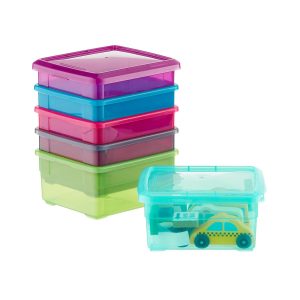
Bins, bins, and more bins. Seems like every time I speak to a prospective client one of the questions is inevitably going to be “How many bins should I get”. The next question is usually “Where should I get bins?”.
As a Professional Organizer you would think that I would love bins. For the most part I do and they do serve a purpose BUT, bins can also create more problems than their worth. Here are some explanations that I’m guessing most of you haven’t considered:
The downside:
• Bins typically become dumping grounds for all kinds of random items, even if the bin is properly labeled.
• Bins, especially large ones, are too cumbersome and usually wind up at the bottom of a heap of other bins and are not easily accessible.
• Bins that aren’t stackable create problems when dealing with limited space.
• People don’t understand the different types of bins and falsely believe that if something is contained in a bin, especially a plastic bin, then it must be protected (Note* See below for additional explanation). This can be problematic when someone discovers, after storing something valuable, that it was not protected as they had thought.
Obviously, there are many good reasons for having and using bins. Bins are one of many tools/supplies that people can use for organizing.
The upside:
• Bins can serve as great storage solutions.
• Bins can maximize your storage space (for example, under the bed storage bins).
• Bins, if you choose the right ones, can protect and preserve important items.
• Bins, if and when properly used, can help keep small items together and from getting out of control (ie, hair accessories, small office supplies like staples, paper clips, push pins, crafting supplies).
It is important to note that all bins are NOT created equal. Believe it or not there are many types of plastic bins. Just because you put something in a plastic bin does not mean that the contents will be protected. For example, if you want to protect memorabilia and you’re putting it in the garage, you may want to consider a bin that is “air-tight” or “water-tight” depending on what you intend to store. They cost more than a regular plastic bin but they protect the contents from moisture and critters.
Quick question: How many of you reading this even knew that air-tight or water-tight bins were an option?
Explanation: Airtight storage bins prevent items from water damage. Watertight storage bins work well in a moist basement or in a humid attic where items may become damp over time. These airtight storage bins have a foam strip in the lid which prevents moisture from getting in. The latching lids work to suction the lid onto the air tight container, to secure the lid to the top of the airtight storage bin. You can use airtight plastic containers for important files, clothes, family photos, collectibles or any item that you wish to preserve. You can also get extra piece of mind knowing that items in your basement or garage are being stored properly and protected from the elements.
As a rule of thumb, we usually suggest that people first use what they have before buying any more bins. In fact, that most people usually have whatever we need on hand (other than the air-tight/water-tight bins) and don’t even know it. We make use of many household items that serve as bins and work just as good. For example, we use the boxes that checks come in for office drawers to organize small items like pens or binder clips. We can use egg crates to store earrings, tupper-ware for small items that need to be contained. This list goes on.
So, next time you feel that you need to run out and buy a bin to help with an organizing project, remember to check first to see what you have on hand. If you determine that you might need a bin or two, think about out what you intend to use it for so that you get the right kind, size and color.
As always, if you are in need of any assistance with your organizing project, give us a call. We would LOVE to be of service!